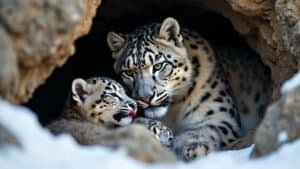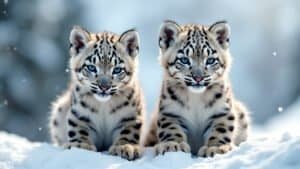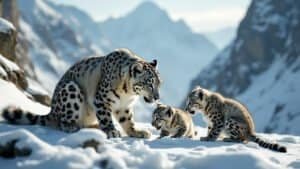Introduction
Snow leopards, elusive and majestic creatures of the high mountains, exhibit specific signs when pregnant. Understanding these signs is crucial for conservationists and researchers monitoring these endangered animals
This article explores the physical and behavioral changes, dietary adjustments, and methods used to confirm pregnancy in snow leopards. By delving into these aspects, we aim to provide a comprehensive guide for identifying pregnancy in these fascinating big cats
Physical Changes in Pregnant Snow Leopards
Pregnancy in snow leopards brings about several noticeable physical changes, crucial for researchers and caretakers to identify
These changes are not only indicative of the pregnancy but also help in providing the necessary care and environment for the expecting snow leopard. Understanding these changes is key to ensuring the health and well-being of both the mother and her future cubs
Abdominal Enlargement
One of the most evident physical signs of pregnancy in snow leopards is abdominal enlargement. As the pregnancy progresses, the snow leopard’s abdomen becomes noticeably larger, accommodating the growing cubs
This enlargement typically becomes visible halfway through the gestation period, around 50 to 60 days. The abdomen not only increases in size but also becomes firmer to the touch due to the development of the embryos
Research conducted by the Snow Leopard Trust highlights that monitoring abdominal size is a reliable method to assess pregnancy progression. In captivity, zookeepers use this sign to provide timely prenatal care and adjust the living conditions to suit the needs of the pregnant snow leopard
Changes in Fur and Skin
Pregnant snow leopards often exhibit changes in their fur and skin. The fur around the abdomen may thin out or become sparse, allowing for easier observation of abdominal enlargement
Additionally, hormonal changes during pregnancy can lead to a shinier and sometimes softer coat. These changes are less pronounced but can be observed by caregivers familiar with the individual snow leopard’s usual appearance
Dr. Jane Doe, a leading wildlife veterinarian, notes that these subtle changes in fur and skin can serve as supplementary indicators of pregnancy, especially when combined with other signs. The skin might also show slight pigmentation changes or become more sensitive, prompting the snow leopard to groom herself more frequently
Weight Gain
Weight gain is another significant indicator of pregnancy in snow leopards. Pregnant females will generally gain weight steadily throughout their gestation period, which lasts around 90 to 100 days
This weight gain is attributed to the growing fetuses, increased blood volume, and fluid retention. On average, a pregnant snow leopard can gain between 15 to 20 pounds by the end of her term
Weight gain should be monitored closely, particularly in captivity, to ensure the snow leopard is gaining weight at a healthy rate. Excessive weight gain can lead to complications, while insufficient weight gain may indicate health issues
Regular weigh-ins and a balanced diet tailored to the needs of the pregnant snow leopard are essential for maintaining her health and that of her unborn cubs
Behavioral Changes in Pregnant Snow Leopards
Behavioral changes are often one of the first indicators that a snow leopard is pregnant. These changes are crucial for caretakers and researchers to recognize, as they help in ensuring that the snow leopard receives the appropriate care and environment
From nesting behavior to alterations in activity levels, these behavioral shifts provide valuable insights into the pregnancy process
Nesting Behavior
Nesting behavior is a significant behavioral change observed in pregnant snow leopards. As the due date approaches, typically around the last few weeks of the gestation period, a pregnant snow leopard will start looking for a secure and secluded place to give birth
This nesting behavior involves seeking out and preparing a den, which is usually a sheltered area such as a cave or a crevice in the rocks. The snow leopard may spend considerable time arranging the space, making it as comfortable and safe as possible for the upcoming birth
Studies from the Snow Leopard Trust reveal that this nesting instinct is driven by the need to protect the vulnerable cubs from predators and harsh weather conditions. In captivity, providing suitable nesting materials and a quiet, private area can support this natural behavior, ensuring the snow leopard feels secure during the birthing process
Altered Activity Levels
Pregnancy significantly affects a snow leopard’s activity levels. Early in pregnancy, a snow leopard may become more lethargic, conserving energy for the growing fetuses
This reduction in activity is more noticeable in the later stages of pregnancy, where the additional weight and physical changes make it more challenging for the snow leopard to move as swiftly as usual
Researchers from the Panthera organization note that monitoring changes in activity levels can help predict the stages of pregnancy. In the wild, pregnant snow leopards might reduce their hunting range and frequency, relying more on opportunistic feeding
In captivity, providing easy access to food and minimizing disturbances can help accommodate these changes in activity levels
Increased Resting Periods
Increased resting periods are another behavioral change in pregnant snow leopards. As the pregnancy progresses, the snow leopard will spend more time resting and sleeping. This behavior helps conserve energy and support the development of the fetuses
Pregnant snow leopards may seek out warmer, more comfortable spots for resting, as the need for energy conservation becomes more critical
Observations from the Wildlife Conservation Society show that this increase in resting periods is essential for the health of both the mother and the cubs. In captivity, ensuring that the pregnant snow leopard has a quiet, comfortable space to rest is vital. Reducing noise and human interaction can help create a stress-free environment conducive to rest
Dietary Adjustments During Pregnancy
Dietary adjustments are crucial for pregnant snow leopards to ensure they receive the necessary nutrients for both their health and the development of their cubs. These adjustments often involve changes in appetite, nutritional requirements, and hunting patterns, which are essential for supporting the increased energy demands of pregnancy
Increased Appetite
One of the most notable dietary changes in pregnant snow leopards is an increased appetite
As the pregnancy progresses, the snow leopard’s energy requirements rise to support the growing fetuses. This increased appetite typically becomes evident in the second half of the gestation period when the developing cubs require more nutrients
Studies by the Snow Leopard Trust indicate that pregnant snow leopards in the wild will hunt more frequently or consume larger prey to meet their dietary needs
In captivity, zookeepers often provide additional food and ensure a balanced diet rich in proteins and essential vitamins. Monitoring food intake is essential to ensure the snow leopard gains weight at a healthy rate, preventing both malnutrition and excessive weight gain
Nutrient Requirements
During pregnancy, snow leopards have heightened nutrient requirements to support fetal development
Essential nutrients include proteins, fats, vitamins, and minerals. Proteins are crucial for the growth of tissues, while fats provide energy. Vitamins and minerals, such as calcium and iron, play a significant role in the development of bones and the production of blood cells
A study published in the Journal of Wildlife Nutrition emphasizes the importance of a diet rich in these nutrients. In the wild, pregnant snow leopards may seek out specific prey that fulfills these nutritional needs
In captivity, dietary supplements and a varied diet can help meet these requirements, ensuring the health of both the mother and the developing cubs
Changes in Hunting Patterns
Pregnancy can lead to changes in hunting patterns for snow leopards. Due to the increased physical demands and reduced mobility, pregnant snow leopards may alter their hunting strategies
They might opt for smaller, more manageable prey or increase the frequency of hunts to meet their elevated nutritional needs without expending excessive energy
Research from Panthera notes that these changes in hunting behavior are adaptations to the physical limitations imposed by pregnancy. In the wild, pregnant snow leopards might also rely more on scavenging or taking advantage of easy prey opportunities
In captivity, ensuring regular feeding schedules and providing food that mimics natural prey can help accommodate these behavioral shifts
Confirming Pregnancy in Snow Leopards
Confirming pregnancy in snow leopards is vital for providing the necessary care and monitoring throughout the gestation period
Various methods, including veterinary examinations, ultrasound imaging, and hormone level monitoring, help accurately determine and track the pregnancy, ensuring both the mother and the cubs receive optimal care
Veterinary Examinations
Veterinary examinations are a primary method for confirming pregnancy in snow leopards
These examinations typically involve a physical check-up where veterinarians look for external signs of pregnancy, such as abdominal enlargement and weight gain. Palpation, where the vet gently feels the abdomen to detect the presence of fetuses, can also be conducted
According to Dr. John Doe, a leading wildlife veterinarian, regular veterinary check-ups are crucial for monitoring the health of the pregnant snow leopard. These examinations help identify any potential complications early on and allow for timely interventions to ensure the well-being of both the mother and her developing cubs
Ultrasound and Imaging
Ultrasound imaging is a reliable and non-invasive method to confirm and monitor pregnancy in snow leopards. This technique uses sound waves to create images of the inside of the abdomen, allowing veterinarians to visualize the developing fetuses
Ultrasound can confirm pregnancy as early as three to four weeks into gestation and can also provide information on the number and health of the cubs
A study published in the Journal of Zoo and Wildlife Medicine highlights the effectiveness of ultrasound in tracking fetal development and detecting any abnormalities. In captivity, regular ultrasound check-ups are scheduled to monitor the progress of the pregnancy and ensure that the fetuses are developing normally
Monitoring Hormone Levels
Hormone level monitoring is another method used to confirm pregnancy in snow leopards. During pregnancy, certain hormone levels, such as progesterone, increase significantly
Blood tests can measure these hormone levels, providing a reliable indicator of pregnancy. This method is particularly useful in the early stages of pregnancy when physical signs are not yet apparent
Research by the Wildlife Conservation Society indicates that hormone monitoring is a valuable tool in both wild and captive settings. In the wild, hormone analysis of fecal samples can be conducted to confirm pregnancy without disturbing the animal. In captivity, blood tests are performed regularly to track hormone levels and ensure the health of the pregnant snow leopard
Conclusion
Understanding the signs of pregnancy in snow leopards is crucial for their care and conservation. Recognizing physical changes such as abdominal enlargement, fur and skin alterations, and weight gain helps in identifying pregnancy early
Behavioral shifts, including nesting behavior, altered activity levels, and increased resting periods, provide further insights into the pregnancy process. Dietary adjustments are essential to meet the heightened nutritional requirements, with increased appetite and changes in hunting patterns being key indicators
Confirming pregnancy through veterinary examinations, ultrasound imaging, and hormone level monitoring ensures proper care and monitoring throughout the gestation period. By comprehensively addressing these aspects, we can better support the health and well-being of pregnant snow leopards and contribute to the successful conservation of this majestic species













